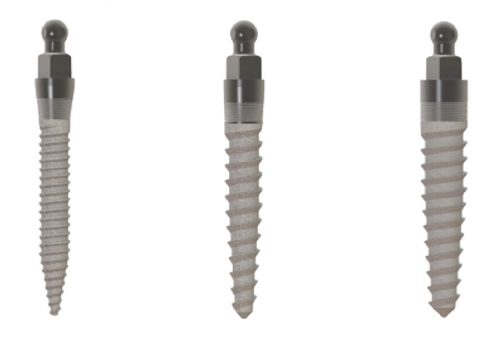
In the past, many people would go to the dentist with the hope of having dental implants placed but were told they did not have enough bone to place a dental implant. With the growing demand for dental implants, dental implant manufacturers began doing research to determine if a narrow style implant could be successful. After years of research and long-term success, the mini dental implant was born. Some people ask, “What is a mini dental implant?”
A mini dental implant is a type of dental implant that is typically 3 millimeters or less in diameter. A little bit wider than a toothpick. This narrow size allows this type of dental implant to be used for people who don’t have enough bone width to accommodate conventional dental implants.
After a tooth is extracted the bone begins to shrink both in height and width. During the first year after a tooth extraction, 25% or more of the bone can be lost in the area and this shrinkage will continue year after year. Over time, this shrinkage can be significant enough to prevent dental implants from being used. When it comes to bone, wider bone is better than narrow bone. Think of it like this, it’s easier to put a screw in a 2 x 4 vs a paint stick.
A mini dental implant is made from titanium, the same material as a conventional dental implant. Mini dental implants are typically a one-piece construction that has the “head” of the implant built into the threaded part that goes into the bone. Conventional dental implants typically are a two-piece construction with the “head” of the implant placed a few months after the threaded part is placed in the bone. Mini dental implants are typically easier to place than conventional implants and the “‘recoup” time is typically also quicker. Most people are back to their regular routine the same day or the next day after having mini dental implants placed. Mini dental implants are also less of an expense than traditional implants.
Mini dental implants are most often used to secure a loose denture, whereas conventional dental implants are used to replace one or more missing teeth with crowns or bridges. The “head” of the mini dental implant is typically ball-shaped and a matching receiver or “snap” is placed inside of the denture. Similar to the snaps on a western shirt, the ball head snaps into the receiver securing the denture so the person can now eat the foods that they have been missing out on.
Typically, it only takes four mini dental implants to lock in a denture on the lower jaw and six for an upper denture. The lower jaw bone, or mandibular bone, is denser than the upper or maxillary jaw bone so it takes fewer implants to secure the lower denture than the upper denture. After the mini dental implants are placed on the upper jaw, the upper denture can have the center part of the denture removed that covers the palate since suction is no longer required to secure the denture.
A denture locked in with mini dental implants also improves the comfort of the denture since the denture will not move around and cause sores because it is locked onto the snaps and doesn’t move or rub. This helps restore a person’s confidence and happiness. They are able to eat the foods they love again and they don’t have to worry about their dentures slipping or coming out of their mouth.
Dr. Rhodes was one of the first dentists in the State of Oklahoma to routinely use mini dental implants. He has placed thousands of mini dental implants and helped people in OKC secure loose dentures and restore their confidence. For over 27 years Dr. Rhodes and Advances in Dentistry have strived to be the best dentist for dental implants in Oklahoma City and has been voted Best Dentist for 6 years in a row.
All content is copyright Advances in Dentistry all rights reserved


